|
|
John o' Gaunt

|
|
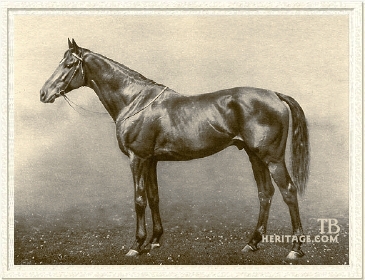 |
|
|
John o' Gaunt, a bred-in-the-purple son of English Triple Crown winner Isinglass and the triple-classic winning mare La Fleche, won just one race, due in part to his poor conformation, in part to ill-luck and the dubious distinction of having an amateur jockey, and in part, maybe, to a thunderstorm on his Derby day. He got one surviving son, Swynford, who could be called a good race horse, and who later became the successful stallion his own sire was not. Americans owe John o' Gaunt a nod, not only for Swynford's sons Challenger II and St. Germans and his great-grandson, Blenheim, but also for Tom Fool, a descendant of John o' Gaunt's daughter, Mandy Hamilton, and for War Admiral, a descendant of John o' Gaunt's son, Harry of Hereford.
|
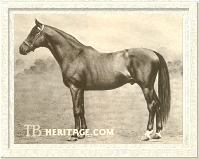
Isinglass as an older stallion
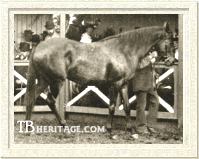
La Fleche in the sales ring
| |
John o' Gaunt's sire was Isinglass, son of the great cup performer of the 1870s, Isonomy, and the Wenlock mare Deadlock. Isinglass, racing for his breeder Harry (later Col.) McCalmont, captured the Triple Crown consisting of the Two Thousand Guineas, Derby, and St. Leger, as well as the Eclipse Stakes and the Ascot Gold Cup during a career in which he was defeated once. In his owner's Cheveley Park Stud, at a fee of 200 guineas, he was naturally a popular stallion from the start of his stud career. Isinglass sired three classic winners, and a son, Star Shoot, became five-time leading sire in the U.S., and as a multiple year leading broodmare sire had a significant influence on American bloodstock.
John o' Gaunt's dam was the champion three year old filly La Fleche, winner of the One Thousand Guineas, the Oaks, the St. Leger, and other important races. She had produced one foal, La Veine, by Morion, when purchased by Jessica Cavendish Bentinck Sykes, through Lord Marcus Beresford, for 12,600 guineas in 1896 at Newmarket's July sales, a fabulous sum at the time, and one Lady Sykes' husband, Sir Tatton Sykes (4th Baronet), ultimately honored, certainly not to his regret, since La Fleche's subsequent foals more than made up the price in yearling sales. In addition to John o' Gaunt she produced Ascot Biennial winner Strong Boy, Champion Breeders' Foal Stakes winner Sagitta; Baroness La Fleche, a stakes winner and producer of a top filly in One Thousand Guineas winner Cinna.
|
John o' Gaunt was her fifth foal, born in 1901 at the Sykes' famous Sledmere Stud in Yorkshire. As the son of two horses, who between them, had won six classic races, expectations were rather high for the youngster, despite his suspicious-looking fetlocks and coronets which hinted at incipient ringbone. He was sent to the Doncaster sales as a yearling, but buyers were leery of his legs, fearing, as it turned out rightly, that he wouldn't stand up to training. He was knocked down to the only bidder, Sir John Thursby, for 3,000 guineas, the opening bid set by Tattersall, and only after Sykes spoke up, guaranteeing the colt for ninety days.
Thursby, his new owner, had succeeded to his father's baronetey in 1901, and became a member of The Jockey Club two years later, eventually serving as a Steward. While John o' Gaunt was trained by William Duke, Thursby later used, as private trainers, F.C. Archer and then Hazleton, who schooled Thursby's horses at Highfield training stables, adjacent to Blink Bonny Stud.
John o' Gaunt on the Turf
John o' Gaunt was put in training with American William Duke, a "master of doping" who had made a reputation of turning cheap claimers into good stakes winners after arriving in Britain. John o' Gaunt ran four times as a juvenile. He was beaten by a head in his debut, a maiden plate at Ascot, and then ran unplaced in the Coventry Stakes there. He started favorite in the British Dominion Plate at Sandown Park, and then ran ten lengths behind the winner, Pretty Polly, who was making her debut. His last race of the season, which was far from over, was the Hurstbourne Stakes at Bilbury Club meeting, the only win of his career. After that, he vanished from view until the next season, possibly sore or possibly because his owner didn't want to risk his iffy legs prior to the classics, or a combination of both reasons.
His first outing at age three was the Two Thousand Guineas, in which he was beaten into second place by St. Amant, by four lengths, with Henry the First two lengths behind in third. In the Newmarket Stakes, two weeks later, he ran second to Henry the First, beaten by a head in a race where turf observers thought he would have won, if not for the riding of his amateur jockey, George Thursby, his owner's half-brother. His next race was the "thunderstorm" Derby of 1904, where he ran second by three lengths to St. Amant (whose ears had been stuffed with cotton); George Thursby later claimed he would have won, but for the storm.
The Derby was his last race; while prepping for the St. Leger he purportedly injured himself by stepping on an old horseshoe, and although he was intended to race in 1905, he could not stay sound long enough to be conditioned. A syndicate of Irish breeders was put together and had John o' Gaunt on offer for £20,000, subject to passing a physical exam; he failed, due to his emergent ringbone. He was instead sent to the historic I'Anson Blink Bonny Stud at Malton, which Thursby had recently taken on a long-term lease and spent a fortune refurbishing.
John o'Gaunt in the Stud
John o' Gaunt started his stud career at a fee of £98, and he was soon fully booked for three seasons in advance. What purchasers did not like when he was on the block as a yearling did not prevent breeders, after watching his career and considering his pedigree, from bringing him their good mares. At first. He started out well enough, with Swynford's big wins at three, and the classic-placed Tootles and Two Thousand Guineas winner Kennymore following soon after, but his offspring did poorly between 1915 and 1918 -- only six winners of £1,264 -- and although his later runners were a bit better, he never came close to siring anything like his early winners. His fee remained at £98 until 1922, and then was reduced to 25 guineas, but even that reduction attracted only 22 mares in his last two seasons at stud, although he got 17 of them in foal. In 1919, Thursby, who died a year later at age 60, dispersed Blink Bonny Stud and John o' Gaunt was sent to the historic Sheffield Lane Paddocks for a year, before its demolition, and then he was placed at the Meddler Stud near Newmarket. On January 7th, 1924, although in perfect health, "and for a veteran, extraordinarily vigorous," he was ordered destroyed by Sir George Thursby. His death "decreed because so few breeders were sending mares to him." He was twenty-three years old.
Without Swynford in his list of offspring, John o' Gaunt would be no more than a footnote in thoroughbred history, although through Bathing Girl, the daughter of Swynford's non-winning brother, Harry of Hereford, he had a significant impact on American racing, and a daughter, Mandy Hamilton was ancestress of Menow, sire of American 1953 champion Tom Fool, later a leading broodmare sire in the U.S. Also, his son, Kennymore got a useful runner in Kerasos, who, in South Africa, became an influential sire. John o' Gaunt's best winner -- and sire son -- was Swynford, who won eight races worth £25,508; his next best runner was the poor-legged Kennymore, who won £9,297 and four races, including the Two Thousand Guineas, and ran second in the Doncaster St. Leger, but he was short-lived and got one decent runner in his one year at stud. The rest of John o'Gaunt's offspring in England were modest winners of relatively small purses, even accounting for the war years in which many of them ran. He often passed on his bad joints and upright pasterns.
|
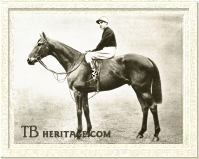
Swynford, his best son on the turf and in the stud
| |
SWYNFORD (1907) was in John o' Gaunt's first crop; he was bred by Lord Derby, and was out of the 1896 Oaks winner Canterbury Pilgrim, who had already produced seven winners, including Chaucer, a high class handicapper and later a great broodmare sire. A late bloomer, Swynford ran once as a juvenile, placing fourth in the Exeter Stakes at Newmarket. At age three he did nothing in the Derby, but ran slightly better in the St. James's Palace Stakes at Ascot, and the day after that race he won the Hardwicke Stakes. He continued his winning after that, first the Liverpool Cup, and then the Doncaster St. Leger.
|
In his next season he won the Princes of Wales Stakes, the Eclipse Stakes, the Hardwicke Stakes and the Coronation Cup, and one other race, and although it was intended that he run another year in the Ascot Gold Cup, he broke a fetlock bone when exercising in the fall of 1911, and that ended his career.
Retired to stud at Newmarket, Swynford became a successful and influential stallion, never lower than seventh on the leading sires list between 1918 and 1926 (he died in 1928), and at the top of it in 1923. He got six classic winners and six classic- placed runners; his most successful runner was his only Derby winner, Sansovino (later sire of St. Leger winner Sandwich). Swynford sired four One Thousand Guineas winning daughters, one of which, Saucy Sue, also won the Oaks, and one daughter, Keysoe, won the St. Leger. It was, however, Blandford, who won three races worth £3,688, the best being the Princess of Wales Stakes, who carried on the sire line. Out of Blanche, by White Eagle, and so in-bred to Isonomy, Blandford was one of the great sires of the English turf, three times leading sire, with four Derby-winning sons. The line continued through Blandford's son, Blenheim, the 1930 Derby winner, and through Blandford's best racing son, Bahram, winner of the English Triple Crown in 1935. Another Swynford son, Challenger II, was a good juvenile, who became a leading sire in the U.S., with a son, Challedon, Champion thee year old. Swynford's son, Doncaster Cup winner St. Germans, also sent to the U.S., was also a leading sire there, getting Twenty Grand, Devil Diver, and Bold Venture. |
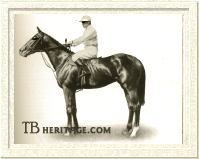
Kennymore
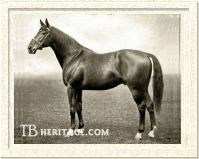
Black Gauntlet
| |
KENNYMORE (1911) was John o' Gaunt's second classic winner, and second best winner, with £9,297 in total winnings. He was bred and owned by Thursby, who bought his dam, Croceum (1898, by Martagon), a useless race mare, in 1907; she had produced two good winners in Sarcelle and Yellow Slave. In addition to winning the Two Thousand Guineas by a short head over Corcyra, Kennymore won the Craven Stakes the previous month, and also won the Dewhurst Stakes. Like his sire and maternal grandsire, Martagon, he had bad joints and was, in addition, extremely vertical; despite this, he ran second to Black Jester in the St. Leger. He died after one season at stud, leaving one useful youngster, Kerasos (1917, out of Quick), behind. Kerasos won three races at age three -- Newmarket's Spring Stakes and Hastings Plate, and the Derby Cup (14 furlongs) worth £2,484. Kerasos was sold to Allan Robertson of Stormfontein Stud in South Africa, and became a very good sire there, leading the sire's list in that country in 1935, two years after his death.
BLACK GAUNTLET (1917), out of Usaa, by Knight of Malta, won Ascot's Hardwicke Stakes and three other races worth £2,592 in Britain's post-war years. The only son of John o' Gaunt at stud in Great Britain in the '20s, other than Swynford, he sired some modest winning daughters, including Blackmail, winner of two plates and placing in several stakes, including the Lambton Stakes in her eleven starts as a juvenile, and Doncaster's Cleveland Handicap at age three; and Termite, second in the Yorkshire Oaks and several other races, and winner of the Fitzwilliam Plate.
|
BURNE JONES (1915), in-bred to St. Simon, being out of the St. Frusquin daughter, Bonny Bay (1906), was purchased to Italy, where he was a very good winner of the Italian St. Leger, the Premio Parioli, the Premio Ambrosiano, and second in the Italian Derby; he also won the Gran Premio di Milano twice. In the stud he sired Italian St. Leger winner Delfino, but otherwise had little effect. Another John o' Gaunt youngster sent abroad was COUPE D'OR, who was a classic winner in Moscow at age three.
John o' Gaunt's other winners included: TOOTLES (1908), an in-bred filly out of Lady Drake, by Gallinule, ran second to Cherimoya in the Oaks, and later bred some modest winners; CARDINAL BEAUFORT, his first winner, who won four races; LANCASTER, another Hardwicke Stakes winner; SPITHEAD, a winner of the Chester Cup and three other races; PORT ROYAL, who won four races; SOBIESKI, COVERT SIDE; CRESSINGHAM; and JACKSDALE, who won six races worth £1,342.
John o' Gaunt's son, HARRY OF HEREFORD (1910), was a brother to Swynford, but unlike him, was a non-winner. Retired to stud in England, after six years he was sold to France. He is primarily seen in pedigrees today through his daughter, Annette K., who was sent to the U.S. in utero, and after an unsuccessful career on the turf became the dam of Brushup, dam of American triple crown winner War Admiral (by Man o' War). Annette K. was also dam of War Glory (1930), winner of eleven of his fifty-nine races, including the Lawrence Realization and the Dwyer Stakes, and later a sire. Another Harry of Hereford daughter, Redhead (1917) was a pretty good winner of ten races, including Doncaster's Park Hill Stakes and the Liverpool Cup, and another daughter, Neroccia (1923) won the Italian Oaks and later produced an Italian classic winner in Niccolo Pisano (1929, by Galloper Light).
As a broodmare sire, John o' Gaunt was moderately successful. His daughter MANDY HAMILTON, sent to the U.S., produced Pimlico Futurity winner Hollyrood, and also Supremus, who got Alcibiades (1927), the dam of Menow, a fair stakes winning horse and sire of Tom Fool and other good winners. NAISHA, was the dam of Kentucky, who won the Dwyer Stakes in the U.S.; TORCHLIGHT, who won two races, produced Tattoo, a Craven Stakes winner; FOREST BLOOM was the dam of Goodwood Cup winner Loosestrife; MOONFLEET became the dam of Condover (1919, by Radium), who won nine of his thirty-three races, including the Coronation Cup and Prix d'Ispahan at Longchamp, and later sired the handsome Xandover, winner of the French 2,000 Guineas and Newmarket's July Cup, among other races and later a sire. DORVAL (1914) won as a juvenile, and later produced Yorkshire Oaks winner Doushka, Irish 1,000 Guineas winner Spiral, and Roidore, a winner in all of his four seasons on the turf and later sire of some fair winners in Ireland and England. MONT ST. JEAN produced Moltalto, who won the Milleniumi Dij in Budapest, and BARBETON DAISY was the dam of Beaumont, who won the Grand Internacional d' Oestende.
--Patricia Erigero
|
|
|
|

